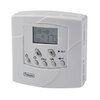I fiddled trying to get it to work for weeks, it would work for a time after each fiddle, then stop again. Original thermostat was this one,
View attachment 217602 and it was not programmable, although worked very well, and if there was no signal in ½ hour (batteries flat etc) it would auto switch off, however the programmer turned off heating at 10 pm completely, and it could get too cold over night, so I added the programmable thermostat to ensure it did not cool too much. It seemed very good to start with, used it free standing, then found living room at 32°C, cured that by adjusting TRV heads, and fixing the thermostat to wall where I had proved it worked, but it slowly went worse and worse, so I abandoned it, and fitted electronic TRV heads instead.
I had intended to fit Nest, but never got around to it, just moved the Horstmann thermostat onto oven carcase facing the receiver
View attachment 217601 and it was still working that way when we sold the house, the other house was hard wired with one of these,
View attachment 217603 that worked far better, and this house has Nest Gen 3 so again hard wired. I tried all the code options and no improvement. But the big problem was no fail safe, if the receiver failed to get the command be it off or on, then it seemed the signal was never resent, so would need to turn up/down or down/up to get the receiver to switch. When I saw with Nest Gen 3 I can manually start it pressing centre of the heat link I thought why don't they all do that? So handy for boiler man, he can test boiler without going to thermostat.





